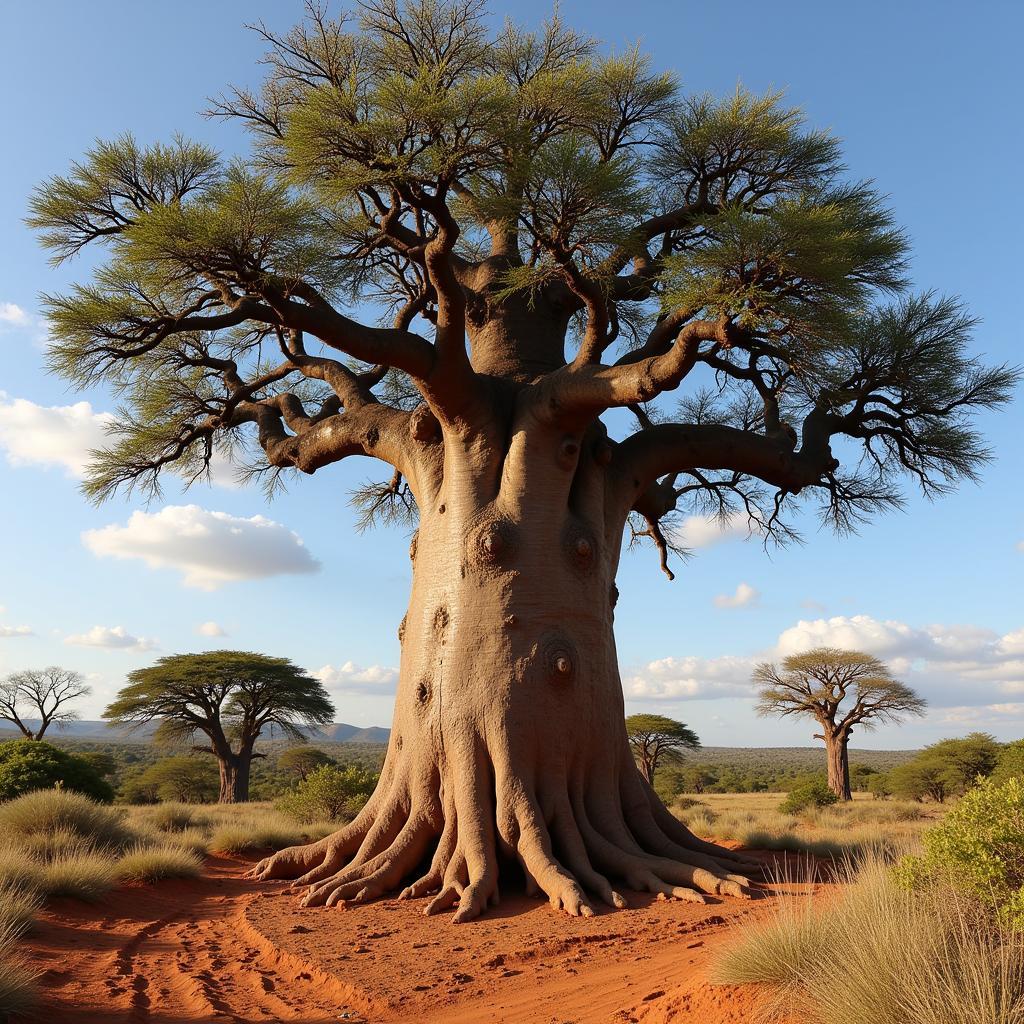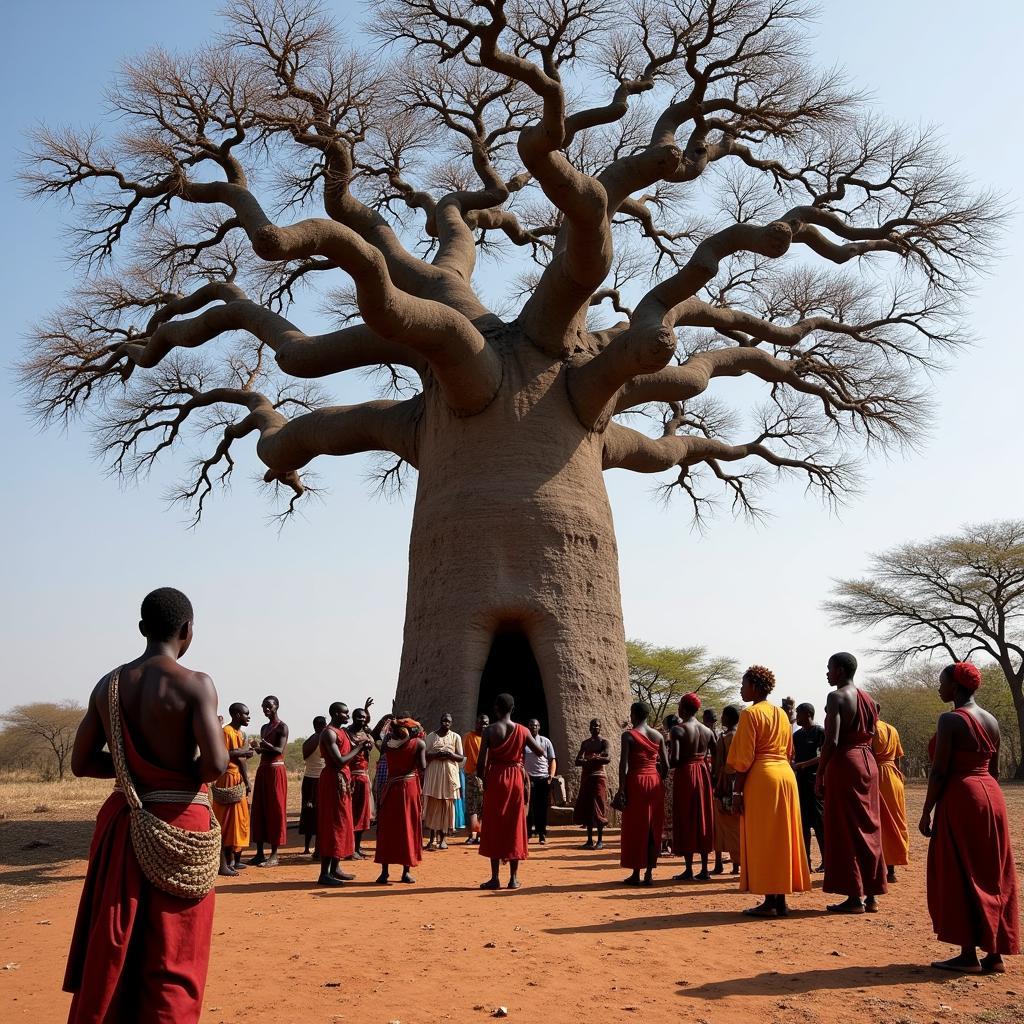Uncovering the Majesty: African Baobab Tree Facts
The African baobab tree, a true icon of the African savanna, is more than just a tree; it’s a symbol of resilience, life, and cultural significance. African Baobab Tree Facts reveal a story of adaptation, survival, and a deep connection to the communities that thrive in its shadow. Let’s delve into the fascinating world of these ancient giants.
The Baobab’s Remarkable Resilience: Adapting to Harsh Environments
The baobab, scientifically known as Adansonia digitata, is a marvel of adaptation. Its unique physique, with its swollen trunk and sparse branches, is a direct response to the challenging climates it calls home. These African baobab tree facts highlight its survival strategies in arid regions. The massive trunk acts as a water reservoir, storing vast amounts of water to endure long dry seasons. Its deciduous nature, shedding leaves during dry periods, further minimizes water loss.
One notable adaptation is the baobab’s fire-resistant bark. Bushfires, a common occurrence in savannas, pose little threat to the mature baobab. The thick bark acts as insulation, protecting the vital inner layers from the scorching flames. This resilience allows the baobab to survive and even thrive in harsh environments where other trees perish.
Here, let’s talk a bit about some other fascinating African trees, including fruit-bearing ones. You might be surprised by the variety! For a comprehensive list, check out this african fruit trees list.
 Baobab Tree Storing Water
Baobab Tree Storing Water
A Botanical Wonder: Exploring Key African Baobab Tree Facts
The baobab’s lifespan is another remarkable aspect of its story. Some specimens are estimated to be over a thousand years old, silent witnesses to centuries of human history. Their immense size is equally impressive. The largest baobabs can reach heights of over 30 meters and have trunk circumferences exceeding 45 meters. This makes them one of the largest living organisms on the planet.
The baobab’s growth pattern is also unique. Instead of forming growth rings like most trees, the baobab’s trunk often develops hollows over time. These hollows, sometimes large enough to shelter people or animals, contribute to the tree’s mystique and cultural significance.
Life Giver of the Savanna: Uses and Benefits of the Baobab
African baobab tree facts extend beyond its biological marvel. The tree provides sustenance and resources for both humans and wildlife. From its nutritious leaves and fruit to its fibrous bark, almost every part of the baobab is utilized. The fruit, rich in vitamin C and antioxidants, is a valuable food source. The leaves, used in traditional medicine and cuisine, offer various health benefits.
Animals, too, benefit from the baobab’s presence. Birds nest in its branches, while mammals like baboons and elephants rely on its fruit and leaves for food. The baobab’s flowers, pollinated by bats and insects, contribute to the biodiversity of the savanna ecosystem. For a deeper understanding of the diverse diets of African wildlife, consider looking at resources like this african grey parrot diet in the wild.
A Cultural Icon: The Baobab in African Tradition
The baobab’s significance extends deep into the cultural fabric of many African communities. It’s often considered a sacred tree, a symbol of strength, longevity, and wisdom. Stories and legends are woven around these majestic trees, passed down through generations. In some cultures, the baobab serves as a meeting place, a focal point for community gatherings and celebrations. To glimpse the deep-rooted connection between African families and these iconic trees, you can explore resources like african family photos holding tree.
Sadly, like many remarkable species, the baobab faces threats. Climate change, deforestation, and overexploitation are putting pressure on these ancient giants. It’s crucial to raise awareness about their importance and support conservation efforts to ensure their survival for future generations. If you’re interested in learning more about endangered African species, you might find this african endangered species list helpful.
 Baobab Tree in Cultural Ceremony
Baobab Tree in Cultural Ceremony
Conclusion: Preserving the Legacy of the African Baobab Tree
The African baobab tree is more than just a botanical wonder; it’s a vital part of the African landscape, culture, and ecosystem. Understanding these African baobab tree facts helps us appreciate its importance and the need for its conservation. Let’s work together to protect these magnificent trees and ensure their continued presence for generations to come.
FAQ
- How long do baobab trees live? Some baobabs can live for over a thousand years.
- What are the uses of the baobab fruit? The fruit is rich in vitamin C and antioxidants and is used in food and traditional medicine.
- Why is the baobab tree important to African culture? It’s often considered a sacred tree, a symbol of strength and wisdom, and a central gathering place.
- What are the threats to baobab trees? Climate change, deforestation, and overexploitation are major threats.
- How can I contribute to baobab conservation? Supporting organizations dedicated to tree conservation and raising awareness about their importance are crucial steps.
- Where are baobab trees found? They are primarily found in arid regions of Africa.
- What is the scientific name of the baobab tree? The scientific name is Adansonia digitata.
Need More Information?
Here are some other topics you might find interesting:
- The role of baobab trees in local economies
- The impact of climate change on baobab populations
- Traditional uses of baobab in different African cultures
When you need support, please contact us by Phone: +255768904061, Email: kaka.mag@gmail.com or visit us at Mbarali DC Mawindi, Kangaga, Tanzania. Our customer service team is available 24/7.

